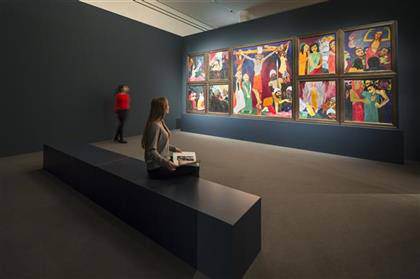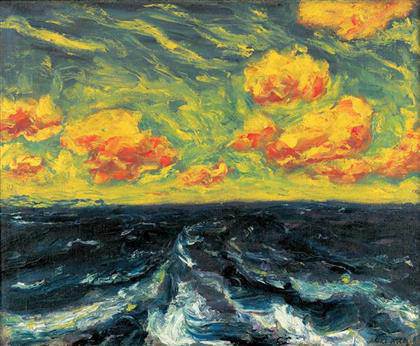
Exhibition view “Emil Nolde. Retrospective”
Städel Museum, Frankfurt am Main
Photo: Norbert Miguletz
© Nolde Stiftung Seebüll

Emil Nolde (1867–1956): Autumn Sea XII, 1910
Oil on canvas, 73 x 89 cm
Sammlung Deutsche Bank
© Nolde Stiftung Seebüll
Emil Nolde. Retrospective at the Städel Museum From 5 March to 15 June 2014, the Städel Museum devotes a major exhibition to the lifework of one of the most prominent German Expressionists, Emil Nolde (1867–1956).]]>
Source: Städel Museum
Although Nolde’s oeuvre has been represented in numerous special thematic exhibitions, the last retrospectiveto pay tribute to his work in Germany took place twenty-five years ago. Some 140works are on view, among them such masterworks as “Springtime in the Room”(1904), “The Life of Christ” (1911/12) or “Candle Dancers” (1912), but also a number ofpaintings and prints by the artist hitherto never shown outside of Seebüll. Realizedwith support from the Nolde Foundation Seebüll and many lenders, the showdraws from new research findings to provide an overview of the wide diversity ofNolde’s oeuvre. The selection ranges from Expressionist landscapes to glitteringnocturnal scenes of Berlin, exotic South Seas motifs, and religious depictions.Arranged in rough chronological order, the retrospective comprises paintings,watercolours and prints from all phases of the artist’s career. A special focus isdirected towards Nolde’s early and late work, which past exhibitions have oftentended to neglect.
“The Städel Museum was one of the first in Germany to acquire works by the GermanExpressionists. The latter are accordingly of great significance for our collection.Following such exhibitions as ‘Ernst Ludwig Kirchner. Retrospective’ (2010) and’Beckmann & America’ (2011/12), we are now very happy to have the opportunity tofeature a further chief exponent of Expressionism in a monographic presentation”,comments Städel Museum director Max Hollein on the project.
Emil Nolde was born on 7 August 1867 in the village of Nolde near the German-Danish border as Hans Emil Hansen. In 1902 he married the Danish actress Ada Vilstrup, and he changed hisname to Nolde after his native village. In 1906 Nolde became a memberof the “Brücke” artists’ group, to which he belonged for eighteen months; in 1908 hejoined the Berlin Secession, from which he was excluded in 1910, however, owing todisagreements with Max Liebermann. Beginning in 1912, Nolde’s works began toreceive wide public attention in Germany; and by the end of the1920s, twenty-one museums had paintings by Nolde in their collections. Nolde joined the Nationalsozialistische Arbeitsgemeinschaft (National SocialistAssociation) of Northern Schleswig (NSAN) which was later among the foundingparties of the National Socialist Party in Northern Schleswig (NSDAPN). However, in 1937 1,102 of his works were confiscated from publiccollections, and 47 of his works, including 33 paintings, were subsequently shown inthe ‘Degenerate Art’ exhibition in Munich. In 1941, he was moreover barred from the“Reichskammer der bildenden Künste” (Reich Chamber of Visual Arts) and prohibitedfrom practising his profession. Following World War II he received numerous distinctions, for example an award for his graphicwork at the XXVth Venice Biennale. Nolde died in 1956 at the age of eighty-eight.
Related content
Emil Nolde. Splendor of Colors. Museum Frieder Burda (exhibition, 2013)
Follow us on:


